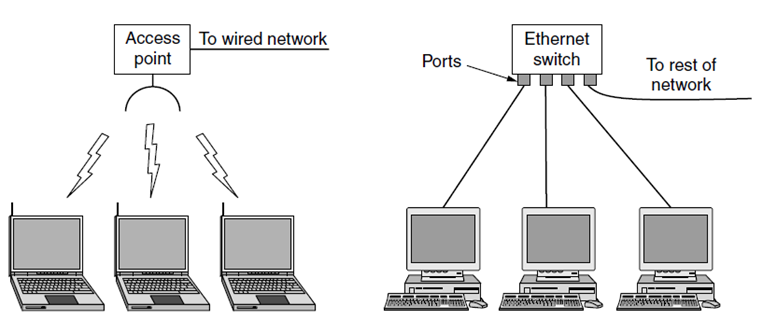Chapter 1- Local Area Network (Part1)
Chapter1 : Local Area Network
1. Definition of Local Area Network (LAN)
A network is an interconnection of devices often called nodes, such as : personnel computers, servers, consumer electronics…etc.
A local Area Network (LAN) is a private owned network. It is a group of connected computers that are confined to a small geographic area, usually one building like a home, office or factory. LANs are widely used to connect personal computers and consumer electronics to let them share resources (e.g., printers) and exchange information.
Wireless LANs are very popular these days, especially in homes, older office buildings, cafeterias, and other places where it is too much trouble to install cables. In these systems, every computer has a wireless network adapter that is used to communicate with other computers as shown in figure 1.1.

Figure1.1- Wired and Wireless Network.
Network adapter : or Network interface card (NIC). Is the device that enables the sending and receiving of data, to and from your computer. It connects to the network by way of cable (wired) or by air (wireless). It has a software component known as a driver that definite the interation with the operating system.
The Access Point (wireless router, base station…) relays packets between the wireless computers and also between them and the Internet. The standard for wireless LANs is called IEEE 802.11, popularly known as WiFi and is very widespread.
Compared to wireless networks, wired LANs exceed them in all dimensions of performances. It is just easier to send signals over a wire or through a fiber than through the air.
IEEE 802.3, popularly called Ethernet, is, by far, the most common type of wired LAN.
In LAN, each device shared the same IP address scheme. For example, if we use a network 172.16.0.0/24, all IP devices, computers, printers, IP phones, etc have the IP from the same network range.
2. Advantages of LANs
Local Area Networks (LANs) offer several advantages over other networks :
- Efficient resources sharing : the sharing of resources (e.g., printers, server…etc) and the exchange of informations (files and media).
- Enhance communication and collaboration: the methods of communication such as : Email, Instant messaging…etc.
- Organization : we become able to centralize data and make it more accessible. Also, network administrators can manage the network from a single location, allowing them to troubleshoot issues more quickly and effectively.
- Cost savings (€€€) : network provide cost saving and increase productivity.
- Improved security : LANs can enhance security by enabling organizations to centrally manage and restricting access to specific resources, applications or services.
3. Essential Features of LANs
LANs are distinguished from other kinds of networks by few characteristics:
- Size : The coverage area is generally a few kilometers.

Figure1.2- classification of Network
- Speed : one of the caracteristic of LANs is their heigh speed data transfer (WANs are slowest). You can achieve a transmission rate of 1 Mb/s to 100 Mbit / sec or higher using different dedicated transmission mediums (Ethernet cable « thin, thick and twisted pair », fiber and wireless transmission).
- Topologies : different topologies can be used. Bus and ring are the most used in LANs.
- Quality : The communication quality is better in LAN and the bit error rate is less than in WAN.
- Cost : LANs have a low cost and relatively simple installation, expansion and maintenance.
Reference
Andrew S. Tanenbaum, and David J. Wetherall, Computer Networks, 5th Edition, China Machine Press, 2011.
